Fibroblast is a type of white blood cell that helps form the connective tissue in our body. Some people use fibroblast therapy to help with arthritis, asthma, and chronic pain. Nowadays, you can even find fibroblast before and after stomach supplements on store shelves.
What is fibroblast treatment?
If you’re looking for a way to reduce fibromyalgia symptoms, consider fibroblast before and after stomach therapy. Fibroblast therapy is a type of treatment that uses the immune system to fight inflammation. You can do this through injections, pills, or heat therapy.
There are many benefits to fibroblast before and after stomach gripping therapy. For one, it can help reduce pain and improve function. It can also improve your mood and help you sleep better. In addition, fibroblast therapy may help you lose weight or manage your diabetes.
If you’re interested in trying fibroblast before and after stomach therapy, speak with your healthcare provider first. You may also want to see if other treatments are more specific to your needs.
Advantages of plasma fibroblast treatment:
There are several benefits to plasma fibroblast before and after stomach therapy that individuals can experience. These benefits include the following:
1. Increased flexibility and range of motion.
2. Improved joint mobility.
3. Reduced inflammation and pain.
4. More youthful-looking skin.
5. Improved blood circulation.
Side effects of plasma Fibroblast before and after stomach

therapy:
There are many potential benefits to plasma fibroblast before and after stomach therapy and some potential side effects. Here is a list of some of the most common side effects of plasma fibroblast before and after stomach therapy:
1. Muscle pain or soreness
2. Bone pain or tenderness
3. Joint pain or stiffness
4. Swelling or fluid accumulation in the legs, feet, or hands
5. Headache
6. Dizziness
7. Nausea and vomiting
8. Insomnia
9. Weight gain
What to expect during the process?:
If you are considering surgery to remove a tumor or other mass cum inside the stomach, it’s essential to understand what to expect during the procedure. The following is a general overview of what will happen but always consult with your surgeon beforehand for more specific information.
Before the Procedure:
You will likely admit to the hospital days before the surgery. That is so that you can prepare the area around your pit in my stomach and do any necessary tests. Your health care team will also give you instructions on how to eat and drink during the procedure.
During the Procedure:
The surgery will typically take around two hours. During that time, the surgeon will make an incision in your pit in my stomach and remove the tumor or other mass. Depending on its location and size, the procedure may require the removal of part or all of your intestine. Sometimes, part of your liver may also need to remove. After the surgery is complete, you may be in pain but typically able to go home within a few hours. You should follow all instructions your health care team gives and keep in mind that you may experience some swelling and discomfort for several weeks after the surgery.
Rehab and aftercare:
If you have fibroids, you might wonder what your options are for recovery and aftercare. Fibroids are benign uterine growths that can grow up to 9 cm (3.5 inches) in diameter. They can cause intense pain, irregular bleeding, and pelvic pressure.
There is no one-size-fits-all approach to recovering from fibroids, but there are a few key things that you can do to help ease your symptoms and speed your recovery:
1. Get plenty of sleep. Sleep is essential for healing and restoring balance in the body. Lack of sleep can lead to anxiety, depression, and stress, all of which can contribute to fibroids. Make sure to get at least 7 hours per night every night during the initial phase of your recovery.
2. Avoid stressors as much as possible. Stress affects the body in many ways, including causing hormone imbalances that can promote fibroid growth. If you’re feeling overwhelmed by your situation, reach out for support from friends or family members or seek out counseling services.
3. Take ibuprofen or other NSAIDs regularly for pain relief. These medications can help reduce inflammation
Fees and reputed specialists:
The cost of a fibroblast before and after a stomach gripping varies depending on the location and type of surgery. The average cost for a fibroblast transplant is $40,000-$60,000. A reputable professional is necessary for this type of surgery. A few surgeons offer reasonable rates, but most charge at least $80,000.
There are many benefits to having a fibroblast before and after a stomach transplant. Fibroblasts are responsible for producing collagen and other proteins in the body. When these proteins are not built correctly, it can lead to chronic diseases such as arthritis, heart disease, and sclerosis. A fibroblast transplant can help to restore average protein production in the body and restore health.
There are several risks with having a fibroblast before and after a stomach transplant. The most common risk is that the transplant will not work. Another risk is that the surgery will be too complex or risky, leading to severe complications. It is essential to find a reputable professional who can help you navigate these risks and ensure that your transplant is successful.
Summary:
Before:
Fibroblasts exist in the stomach cardiac as a type of cell that helps with digestion. They are also found in other body parts, including the skin and lungs.
After:
After treatment, fibroblasts have decreased numbers and are no longer found in the stomach cardiac. That may indicate that the treatment is working.

Im excited to find this website. I need to to thank you for your time due to this wonderful read!! I definitely loved every little bit of it and i also have you book marked to check out new stuff in your blog.
thanks for your reply
Nice post. I learn something new and challenging on websites I stumbleupon every day. It will always be useful to read through articles from other writers and use a little something from other websites.